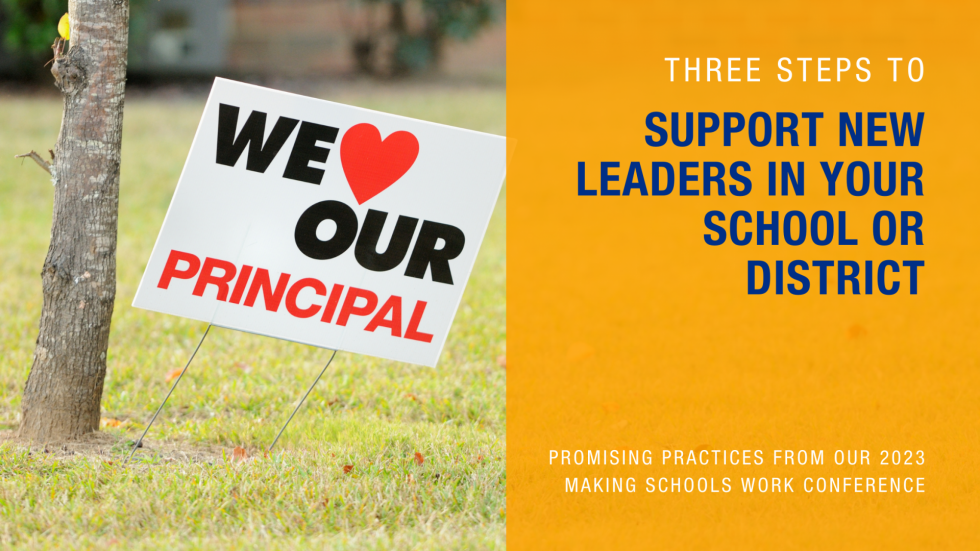Supporting New School Leaders to Create Great Schools: Three Steps Towards Powerful Leadership
Prefer to listen? Check out the audio recording of this post instead.
Let’s be honest: When you hire a new leader in your school, you likely select them because you believe they have an aptitude towards leadership, but that doesn’t mean they are fully there yet.
Just like anything, becoming a leader takes time and practice. To get to the places you want them to be, you are going to need to offer some support.
In our 2023 Making Schools Work Conference presentation, “Support for New Leaders,” we discussed ways for you to support the new leaders in your school or district.
Step One: What Do They Need?
One of the first things you can do to help a new leader is offer them a needs assessment.
Here are some things this will help them (and you) figure out the strengths and challenges of:
- Themselves
- The specific position they have taken
- The school
Finding out all of these will allow you to figure out how you can best support them as they grow into the leader you know they can be.
One easy way to accomplish the leader-based assessment process is through the Compass Points protocol.
Additionally, SREB can help you conduct a school-based assessment.
Step Two: Create an Action Plan
Once you have completed the assessment, it’s time to create the gameplan.
A lot of research goes into creating an effective action plan. Along with your needs assessment, you might want to research causes and drivers of the strengths and weaknesses that you found. This will help you address the root causes of your weaknesses and find ways to utilize the drivers leading to your strengths.
You also want to have clear goals in play and figure out how you will measure those goals.
Once you know what is working and what isn’t, what is causing everything to work or not and where you want to go from here, you can create your plan of action.
This is not something one person will do on their own. We recommend creating a focus team(s) of teachers and leaders to help you develop and implement your plan. There are a few reasons for this:
- Teachers have thoughts on what should be done in the school.
- Teachers are often the ones who end up dealing with the changes being made, so they should be part of the process surrounding the changes.
- You don’t want your whole plan contingent on a leader who could decide to leave. Having a focus team representing a wider view of the school means it is more likely to keep in place even when a leader does not.
- It creates a team environment where responsibilities are shared, communication improves and better ideas are created.
You can create various focus teams for each area of school improvement, which lets you have multiple priorities at once while also allowing you to bring in more voices into the plan.
There are still many important roles for the leaders in this process. Let’s look at some of their roles on these focus teams:
- They establish expectations for the focus teams. For example, they may assign duties and deadlines.
- They track all of the school’s focus teams and prioritize the goals for each.
- They help monitor implementation and assist with any setbacks the teams find.
While the action plan still allows for a significant need for good leaders, it also takes some of the work off the leader and gives them clear goals to help them with the process.
Step Three: Give Them the Resources They Need to Get the Job Done
Now that you’ve created an action plan, it is time for your leaders and their teams to implement it.
But how can they do anything if they don’t have the tools to do it?
If you want to support your leaders, new or old, then you can start by helping ensure they have what they need to get their job done.
Think about some of these questions:
- What problem(s) of practice does your school(s) have? (This was likely identified in your assessment.)
- What can you do to fix that problem? (This was likely identified in your action plan.)
- What tools/resources/services do we need to implement that solution?
- How can I get those tools/resources/services to the school leaders to make sure our goals are met?
When you have answered all these questions and provided your leaders with the right tools, you are well on your way to creating a powerful leadership team who will do great things for the kids that walk through the school’s doors.
Final Thoughts
Whether you have just hired a new principal, other leader in the district or you are a new leader, these steps will help you build up a leadership team that will have the results you want to see for your students.
Subscribe to our newsletter to get more advice like this.





